Handstands work your core and improve balance while giving you the benefits of increased circulation and lymph flow. You’ll engage your whole body while using your shoulders, arms, core, and back.
Take a look at these handstand prep options and variations. There are plenty of options to suit all levels and abilities.
We go through the moves below as a progression, but every day is different when doing handstands. Return to these moves often and whenever they feel right for you.
To build strength
Here are some exercises that will help you put more weight on your hands and arms while having one or both legs in the air. They will also help you get used to being upside down and build up core and arm strength for stability.
One-legged Downward Dog
1. From Downward-Facing Dog, lift your right leg as high as you can, keeping your hips squared or parallel with the ground.
2. Press into both palms evenly.
3. Raise your left heel off the ground so that your weight is in the ball of the foot.
4. Lift your right leg higher as you yield your weight into your hands.
5. Do 5-10 repetitions on each side.
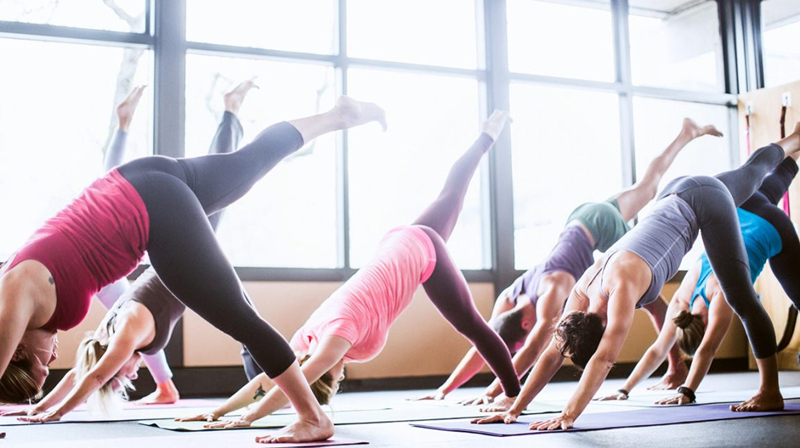
Kick-ups
With this move, you practice “hopping” on to your hands by briefly picking both feet up off the ground.
Share on Pinterest
1. Start in the Downward Dog position with your right leg raised.
2. Bend your left knee and kick your left foot off the floor, lifting your right leg more. This will only last a quick second at first before you land back down.
3. Do 5-10 repetitions on each side.
Next, try hopping up with both feet at the same time. Do 5-10 repetitions.
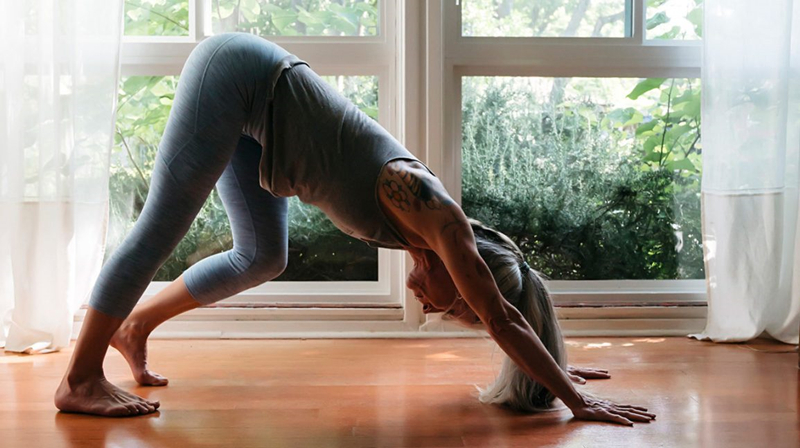
Inversion sling
If you want to get used to being upside down in a supported way, try an inversion sling.
If you haven’t used an inversion sling before, a beginner aerial yoga class is a useful introduction to using this kind of equipment. An instructor can lead you through several movements and poses, and offer adjustments and pointers.
1. Place cushions or a folded blanket in the fabric of the sling.
2. Position the fabric around your lower back.
3. Hold onto the sides of the fabric as you drop back.
4. Wrap the fabric around your legs for support as you hang upside down.
5. Allow your hands to hang overhead.
6. If possible, press your hands into the floor as you would for a handstand for a few seconds at a time.
7. Hold this position for up to 5 minutes at a time.
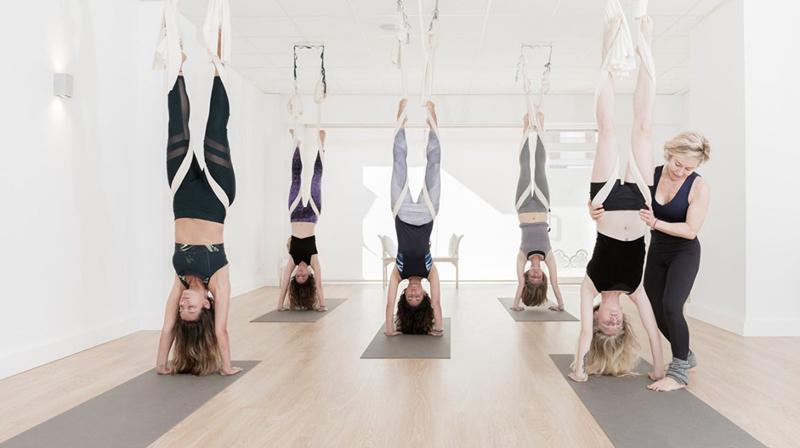
Inversion sling options
Find a studio in your area that has inversion slings available during regular or aerial yoga classes.
Using a TRX suspension trainer is another option. Shop for TRX suspension training kits here.
Pike wall hold
This position will help you to develop upper body strength and get used to having your feet off the floor. You can experiment with moving your feet into a higher or lower position. You can also use a box, step, or the seat of a couch in place of a wall.
1. Sit with your back against a wall and your feet extended in front of you.
2. Make a horizontal mark on your mat next to your heels.
3. Then come into a tabletop position, aligning your wrist creases on the line, or putting your hands where your heels had been.
4. Move into Downward-Facing Dog by pressing into the floor with your hands and lifting your hips up toward the ceiling.
5. Place one foot at a time on the wall behind you and walk your feet up the wall until you are in an L shape.
6. Allow your neck to remain neutral with your ears in between your upper arms.
7. Hold this position for up to 1 minute.
8. Repeat 2-3 times.
As you progress, you can walk your feet higher up the wall to bring your shoulders, hips, and heels in one line.
Once you’ve mastered the pike hold, you can walk your feet higher up the wall as you walk your hands in close to the wall to come into a full handstand position.
With this move, your stomach will be facing the wall.
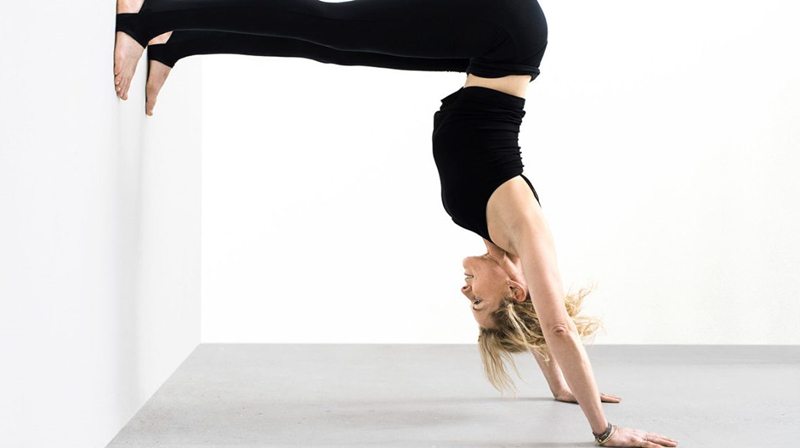
Handstand with and without the wall
A wall is a great support device or “spotter.” Use the wall as a touch point as you build up balancing on only your hands.
These two approaches have you come into a handstand so that a wall is behind your back.
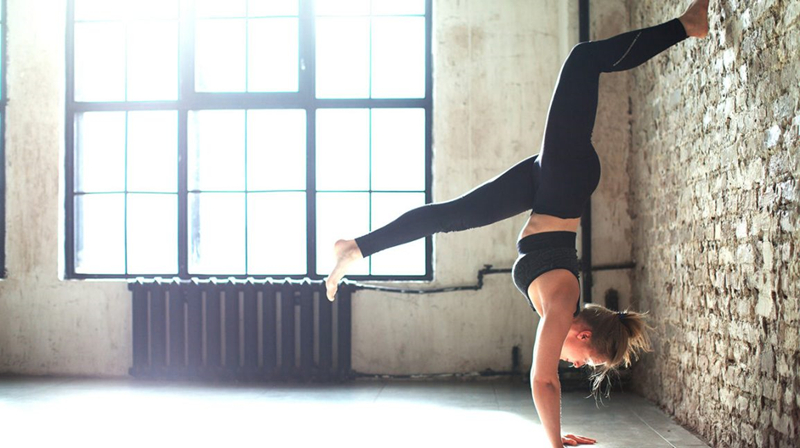
Handstand approach #1
1. Stand with your right foot in front of your left foot and your arms raised. If you prefer, begin in a Downward-Facing Dog instead of this standing lunge.
2. Lift your right foot slightly. Then lower it back down to the floor as you place your hands on the floor and kick up your left leg, and then your right.
3. Align your body so that your feet, hips, and shoulders are in a straight line and hold this position for as long as possible.
Handstand approach #2
Start in Downward-Facing Dog or folded forward with your hands on the ground, one to two feet from a wall.
Pressing your hands into the ground slightly wider than shoulder distance, then lift your hips above you, keeping your legs and feet engaged.
Imagine squeezing your thighs together and lever your legs and feet up above your head.
Align your body so that it’s stacked vertically over your hands and hold this position for as long as possible.
Once you get the hang of it, plant your hands farther away from the wall so that your feet only touch the wall if you move too far forward.
Flexibility and strength poses to practice
Chair Pose
Crow Pose
Downward-Facing Dog and variations
Feathered Peacock Pose
modified handstand pushups
Plank Pose variations,including Side Plank Pose
pushup variations
Rabbit Pose
squats
Standing Split
Warrior III
To walk it out and challenge balance
If you’ve mastered a standard handstand, you can have fun trying out some of these variations. You can do these exercises freestanding, against a wall, or with the help of an inversion sling. You can also start in a piked position to get a feel for the movement.
Sideways hand steps
1. From a handstand position, lift your left hand slightly off the floor.
2. Place it slightly to the left and then bring your right hand closer to your left hand.
3. Align your body so shoulders and hips are above your wrists.
4. Do 5-10 hand steps in each direction.
Shoulder taps
1. Keep your body strong and engaged throughout this variation. If you can’t reach your hand to your shoulder, try lifting one hand slightly off the floor for a few seconds at a time.
2. From a handstand position, lift your right hand and tap your left shoulder.
3. Return your hand to the starting position.
4. Then do the left side.
5. Do 5-10 repetitions on each side.
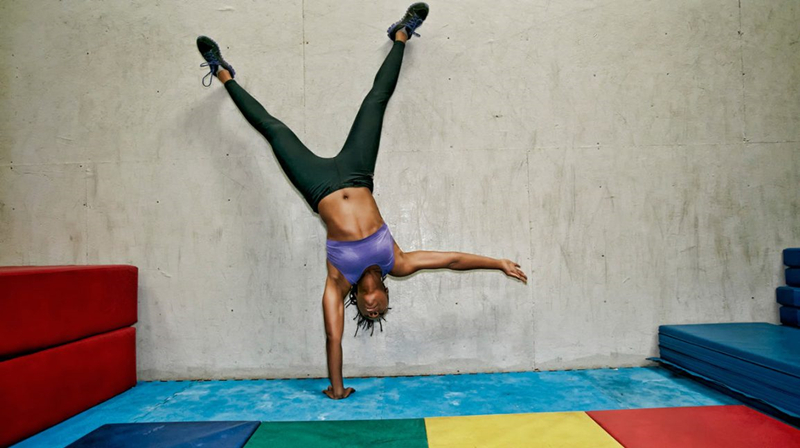
Leg variations
While in handstand, try out various leg positions, including:
wide-leg splits
front-leg splits
butterfly legs
eagle legs
Things to keep in mind
If you’re just starting, work on building muscle in your body and getting used to the idea of your hips and legs being over your head.
Find a friend or teacher who can assist you, since sometimes simply having someone stand next to you can give you the confidence to try new things.
Being upside-down can be a bit disorienting, so it’s also nice to have someone able to provide you with clear alignment cues and help you figure out which corrections to make.
Prepare to come back down
Roll out of it. If you feel yourself falling out of a freestanding handstand (no wall behind you), tuck your chin and knees into your chest and roll out of it.
Step out of it. If you’re falling to the side, try to bring your foot down to the floor.
Cushion. Place a few folded blankets or cushions on the floor if it helps you to feel more at ease.
When not to handstand
Avoid handstand when you have:
any back, shoulder, or neck concerns
a heart condition
high or low blood pressure
any concerns with blood moving to your head
glaucoma
Women who are menstruating or pregnant should avoid inversions unless practicing under the supervision of a yoga teacher.

 中文
中文